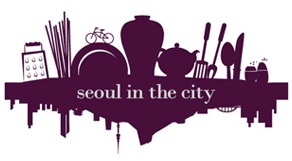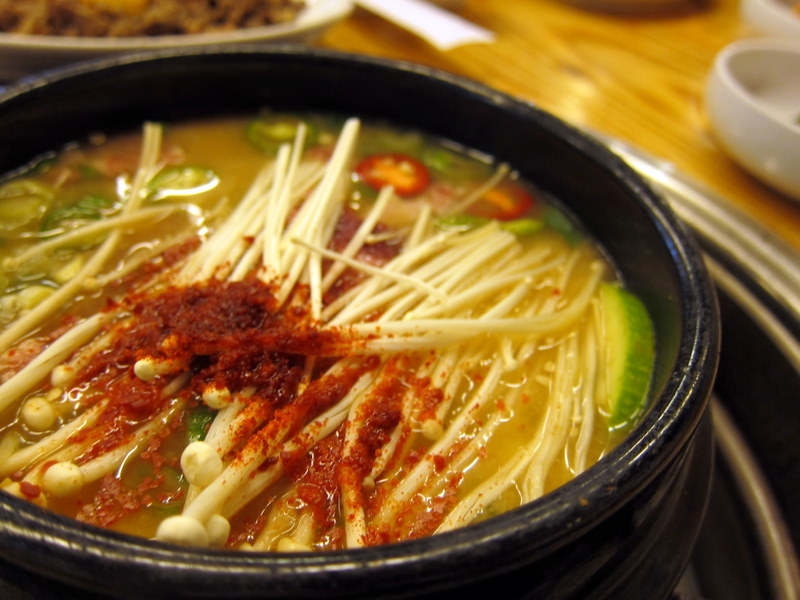I am honored to introduce fellow food lover-Sue Park from Seoul, as a guest blogger with Seoul in the City's 'weeknight affair series'!
Sue-one truly spirited, sweetheart, and a close friend...is a dj on Seoul's TBS EFM (English) radio 101.3, 'M-Town' show. When it comes to food, you'll be in good hands with this foodie. 'My Seoul' will not be complete without Sue...
Ask a non-Korean what their favorite Korean dish is and there is a high probability that bibimbap will land in the top 5 of the list alongside galbi, bulgogi, samgyeopsal and samgyetang. Yes, Koreans do love their meat!
Unlike some of the more pungent dishes that constitute a typical Korean meal, including bubbling hot spicy stews eaten straight out of a communal pot like kimchi jjigae and doenjang jjigae which, due to the fermentation process of their core ingredients, may not be instantly appealing to first timers, bibimbap is easy—a mound of steamed rice (hot or cold) placed at the bottom of a bowl topped with an assortment of namul (sautéed and seasoned vegetables), sliced or minced beef (cooked or raw) and a single egg placed on top (fried, sunny side up, or raw). The entire concoction is mixed with gochujang (red chili paste) which is usually served
on the side and a dribble of fragrant toasted sesame oil! It is delicious, hearty and nutritious – the meal is complete in itself with, at most, a bowl of hot broth on the side and kimchi. The dish is even airplane-friendly, served as a popular in-flight meal on major international carriers.
Then, we have a variation of this dish, dolsot bibimbap, which literally translates into stone pot bibimbap. Dolsot bibimbap is the same basic bibimbap formula served in a sizzling hot stone pot with usually a raw egg, instead of a fried egg, on top. The ingredients are mixed right before it is eaten and the raw egg is cooked on the side of the hot stone pot. The pot is very hot, so you better watch your fingers! If you’re like me, leave a thin layer of rice at the bottom of the pot which turns brown and crunchy by the time you finish your meal. You can use your spoon to scrape away the crispy bits stuck to the bottom! (I doubt this would pass as polite table etiquette in Korea so I only do this in the presence of people who know me well.)
Dolsot bibimbap originated from Jeonju, the capital of North Jeolla Province, home to its version of bibimbap, famously called Jeonju bibimbap, which is said to be based on the royal court dish of the Joseon Dynasty. Although bibimbap can be served hot or cold, traditional Jeonju bibimbap is still served to this day in a brass bowl to keep the rice warm till the end of the meal. If you have a hankering for dolsot bibimbap, it isn’t difficult to find a place that serves it– for example, one of the ubiquitous 김밥천국 (gimbop chungook) chains! The thing about dolsot bibimbap or any variation of bibimbap is that because all the ingredients are mixed together with gochujang, which is thick, spicy and quite strong in flavor, there is a chance they will pretty much all taste uniform no matter where you eat it. You can’t go horribly wrong when it comes to bibimbap, if you know what I mean. However, if you are a dolsot bibimbap fan and want to try a version that stands out without having to travel all the way to Jeonju, 참숯골 (Cham Sut Gol) may have the answer to your bibimbap desires!
The restaurant is located in the heart of downtown Seoul, on the main street of 무교동 (Mugyodong), studded with humble but long-established eateries that have been in existence for decades, feeding the daily exodus of famished office workers wandering around in search of something good and affordable to eat. During lunch hours, the tiny alleyways and their restaurants are packed with lunch crowds; it’s quite literally walk in, order, wolf down, pay and walk out for these people as they also need to grab coffee or tea within their one-hour lunch break before they head back to the office. Reservations are a must for the more well-known establishments or you will find yourself inevitably waiting in line until the crowd thins out. The area known as 무교동 (Mugyodong) is behind Sejongno road (the main strip that leads up to Gwanghwamun from Plaza Hotel) where the Seoul Finance Center and the Seoul Press Center buildings are located.
So, back to 참숯골! By day, it serves relatively simple but sturdy lunch fare like dolsot bibimbap, galbitang (clear Korean beef soup made primarily from beef short ribs with stewing beef and vegetables like white radish, onions and leek), dolsotbap (not to be confused with dolsot bibimbap. Dolsotbap is rice steamed in a special stone pot with fresh ginseng, chestnuts, dried dates, gingko nuts, peas and carrots and served with galbitang on the side), naengmyeon (cold buckwheat noodles in chilled beef broth) and doenjang jjigae. By night, however, it turns into a barbecue house that is known for serving top quality cuts of Korean beef, including short ribs, sirloin and rib eye. Naturally, the dinner menu is pricier!
So, what is it that makes 참숯골 dolsot bibimbap stand out? For one thing, it is definitely more “upscale”, featuring a good variety of fresh namul and meat. Also, if you’re vegetarian and have always had to go through the trouble of ordering bibimbap without meat, well, dolsot bibimbap served here comes with meat and egg on the side! 참숯골 prides itself in its meat quality, so that means the meat that comes with the bibimbap is naturally also a more upgraded version. For each order of dolsot bibimbap, customers get an individual side of meat, a small pile of thinly sliced barbecued brisket (one of my favorite cuts of beef!) topped with a single raw egg yolk. Carefully slide the beef and egg yolk onto the stone pot filled with rice and vegetables, add gochujang and mix! I always ask for more sesame oil because an extra drizzle makes the whole concoction moist and fragrant. When you order dolsot bibimbap, make sure you order their doenjang jjigae. It is an absolute must! Filled with tiny pieces of fatty brisket, loads of vegetables and a big chunk of tofu sitting at the bottom, 참숯골’s doenjang jjigae is the perfect accompaniment to dolsot bibimbap.
Another reason why I want to give this place a few extra points—one of the side dishes that comes with the meal is 명란젓 (myeongnanjeot) or salted and preserved pollack roe. Here, it is served seasoned with minced garlic, spring onions and sesame oil. It is really hard to come by restaurants that serve myeongnanjeot as a side dish because good-quality pollack roe is expensive. I advise you make a reservation, in advance, as the place is always packed during lunch hours. Don’t’ expect good service but do expect quality food.
Smiling with Sue!!!
@ Cheongyechun river
Just having fun after lunch...
(bobby likes to stand out, while june, linus and sue are posing for their album cover)
참숯골 (Cham Sut Gol)
Jung-gu, Mugyo-dong 19, Seoul/서울특별시 중구 무교동 19 체육회관빌딩 2층
2nd floor of Cheyuk Hoegwan Building
02) 774-2100
Subway: Walk out of Gwanghwamun Station (line 5) Exit 5, locate Seoul
Finance Center and commence to walk towards the back of the building. The restaurant is across from Starbucks on the 1st floor of Kolon Building)











